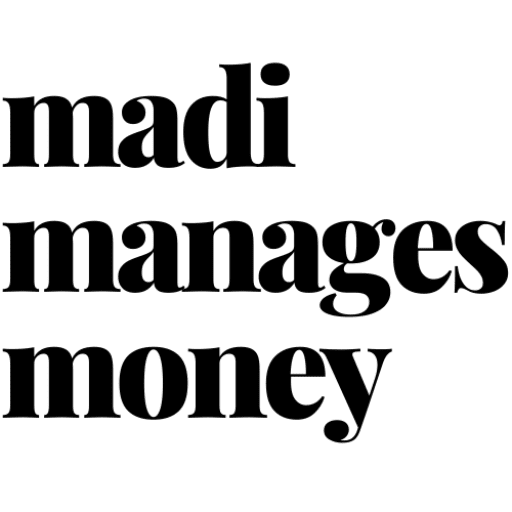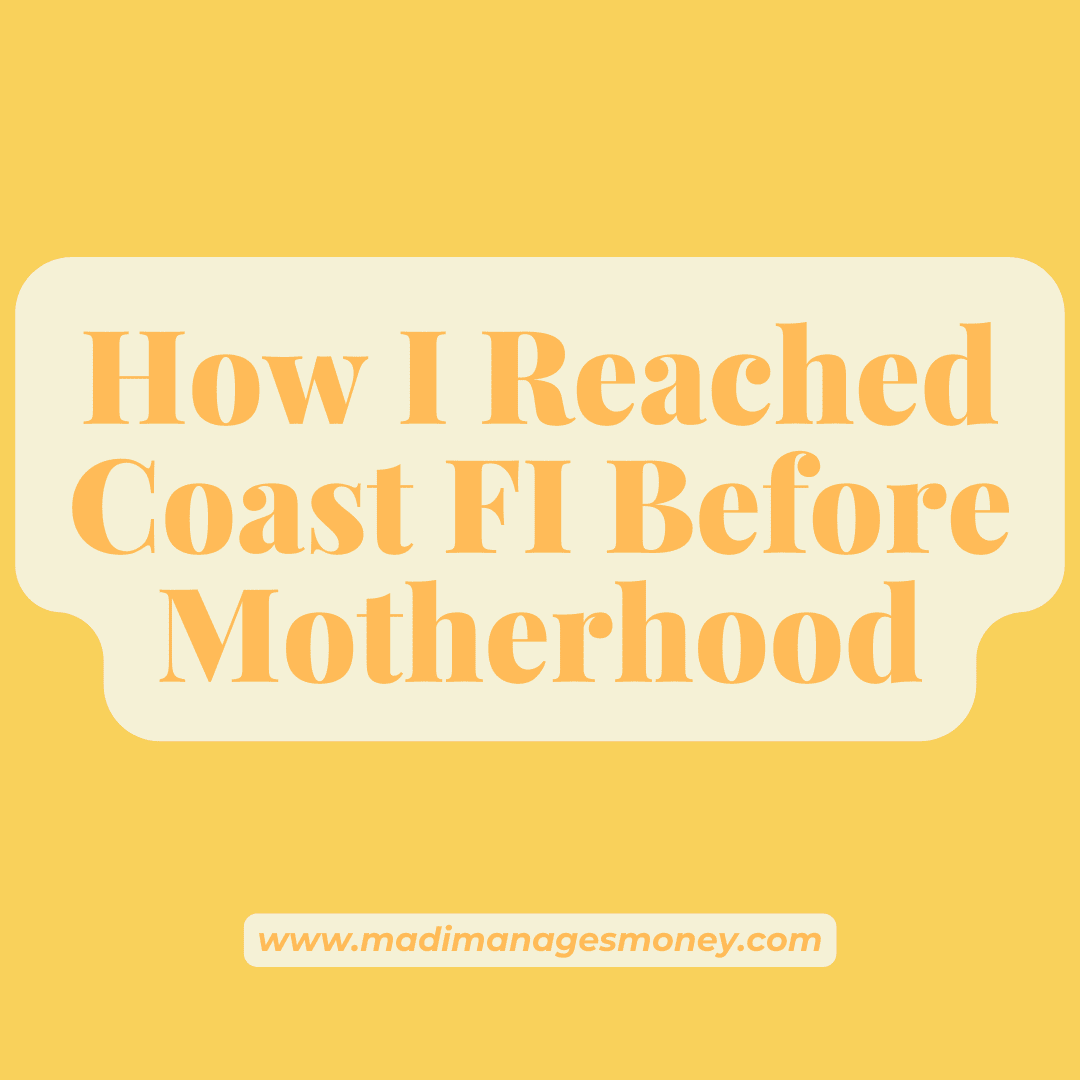I’m a mom who has reached Coast FI. This is how I did it.
I’m a 33-year-old married woman with a young daughter. Over the past several months, I’ve taken a break from corporate America to spend time with her and pursue other ventures, like writing this finance blog for other moms.
The kids call my financial status Coast FI these days.
You reach Coast FI when you have enough money saved to pay for retirement in the future, even if you never contribute more to your investment accounts.
(I’ll link a Coast FIRE calculator at the bottom if you’re curious about your numbers.)
Thanks to the decades our money will spend in the stock market, my husband and I can let compound interest do the hard work for us. For now, we use his income to cover expenses and continue investing. I want to be absolutely positive we have enough money to cover things like medical expenses as we age.
I didn’t draw it up like this.
Despite the shameless hustle of my twenties, I never identified with the financial independence community, much less planned to take a break from work. Had you asked 25-year-old me to predict the future, I’d guess I’d have two children, hire a top-notch nanny, and continue a rewarding (yet somewhat intense) career in finance.
Then, I had a baby, which felt like the career equivalent of being struck by a meteorite at my desk.
As it turns out, those choices I made earlier in my life, the ones aligned closely with the tenets of FI/RE, gave me options I didn’t know I needed. Investing gave me the freedom to lean into family life, to turn down jobs incongruent with my lifestyle, and to try new things.
Here’s how I achieved Coast FI before becoming a mother. If you’re already a parent, don’t be discouraged. The ways I made most of my money can be copied even when you already have kids.
Here’s my Coast FI story.
The Real Estate Escapades
In 2014, I was 24 when I purchased my first home. It was a pink, ancient duplex in the Northside of Pittsburgh that I had no business buying. (When I die, all I ask is that you write on my tombstone, “She didn’t do things halfway.”)

My confidence was bolstered by my brazen, feminist real estate agent and then-boyfriend (now-husband) who owned a new Milwaukee drill set and a pickup truck. I signed on the 78 dotted lines of my 30-year, fixed-rate FHA loan paperwork, and she was all mine.
With my financial prowess and my husband’s construction know-how (which were both suspect, tbh), we were off to the house-hacking races. For the next several years, we lived on one side of the duplex while renting the other and enduring ongoing renovations.
Rental income offset the mortgage payment, so I effectively lived for free during most months. As a result, I could shovel some extra money into my investment accounts and pay for renovations.
As if we weren’t crazy enough, in 2018 we purchased a second property just east of Pittsburgh for $55,000. I tell you the price because it’s the most succinct way to explain what we were getting ourselves into. If you’ve ever sorted Price (Low to High) on Zillow, you know the one.
We moved out of the duplex and into the single-family fixer-upper another two years later. Real life renovations are slower, dirtier, and more expensive than even the most realistic HGTV shows. We still live in this house today!
Finally in 2020, we closed the duplex chapter after selling the place at a capital gain, only half of which was tax-free thanks to the Section 121 Exclusion. (This hard-earned tax lesson is worth a blog post on another day.)
W2 Work & Landscaping
While real estate is exciting, it took up a disproportionate amount of my (and my husband’s) free time.
Where we actually made most of our money is less sexy. We both took home decent wages as W2 employees and did a little side-hustling.
I was (and still am) the gal at work who’s forever pursuing the next credential or project. Each performance cycle, you bet your ass I come armed with a spreadsheet of my accomplishments and ways I make my boss’ life easier.
Laser focus on increasing my salary and maximizing benefits at work is deliberate. It quite literally pays! Plus, when you consistently do your best for your boss and teammates, advocating for yourself is genuine and should be expected.
Then, there was the landscaping phase. To earn extra money, I leaned on an old skill from adolescence. I moonlit in landscaping 3-4 days a week during the summer. After work, I’d change into my outdoor gear, pack my cooler, and rumble in my 2003 Toyota Corolla to wherever our crew was in the city.
In less than ten years, I’d more than tripled my total compensation. My income growth primarily came from a.) raises and b.) two jobs switches that required joining a new company.
Related Post: My Salary & Investing Story
Keeping Expenses Low & Investing Excess Cashflow
Meanwhile, I kept my living expenses low to maximize what I had leftover to invest.
Living in a low cost of living area like Pittsburgh made this math much easier. Plus, I avoided buying things I didn’t need that didn’t align to my values, like a new car.
(There’s nothing wrong with buying a car. They spark zero joy for me, is all.)
I didn’t keep a detailed budget at the time but instead focused on hitting my investment goals. As long as I did that, I didn’t go full forensic accountant to inspect where every dollar went.
I dumped extra money, even if it was only $50-$100 here or there, into the global stock market via low-cost index funds. First, I maxed out my tax-advantaged retirement accounts following this order, then moved on to my taxable brokerage account.
In the early years, I was only pulling ~$50,000 salaries, so the amount I invested was modest. But! More important than the dollar amounts I invested is the length of time my money could work in the market. If you’re in your 20s or 30s, longevity is the ultimate investing trump card. Take advantage of it!
Young Madi didn’t know exactly what she was investing for, aside from just trying to get her cake up. Reaching Coast FI wasn’t a twinkle in my eye.
Truthfully, my story should have started with my parents, who are my launch pad. Having very modest student loans to repay once I graduated school radically changed my starting line. My parents are the reason I had the confidence and stable financial footing to start investing when I did.
Related: Download My Free Budget Template
You can do this, too.
If you’re thinking, “Madi, I’m not a 24-year-old looking for a crusty, old duplex to flip,” you’re in luck. I’ve gotten help from the real estate market – make no mistake about it – but that part of my financial independence story is the sizzle, not the steak.
The biggest contributors to reaching Coast FI have been:
- Growing my salary at my day job
- Investing in diversified, low-cost index funds for the long haul
- Taking some calculated risks
- Trying new things before I’m an expert / learning as I go
These factors are all replicable, even if you have children already or aren’t in your 20s anymore. The same goes for paying off student loans. Don’t let any of those circumstances discourage you. Instead, focus your energy on taking small steps that add up over time.
Keep in mind I’m not exactly out to pasture writing my memoirs at present. I’m 33 and not special in any way. If I can make progress like this in less than 10 years, so can you, especially if you (and/or your spouse) are entering the meat of your career and enjoying higher-earning years.
Nothing I did, in isolation, was exceptional. It was daily decisions, albeit small, that compounded until they reached a critical mass.
When you’re just starting, investing feels like small drops in a bucket. Keep going, and you’ll be stunned by what they add up to over long periods of time.
Madi 😊
Related Post: Financial Freedom by Grant Sabatier (Book Rec!)
Resources
The opinions voiced in this material are for general information only and are not intended to provide specific advice or recommendations for any individual. To determine which investments may be appropriate for you, consult with your financial advisor.

